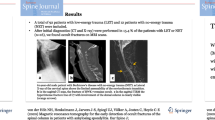Abstract.
The purpose of this study was to evaluate the healing capacity of fatigue fractures of the pars interarticularis in young elite athletes. Between 1991 and 2000, a fatigue fracture of the pars interarticularis was diagnosed in 34 highly competitive athletes. The study group included 28 athletes with a mean age of 17.2 years at diagnosis (range 12–27 years). The average time per week dedicated to sports was 10.9 h. Diagnosis was made with both planar and single-photon-emission computed tomographic (SPECT) bone scintigraphy and computed tomographic (CT) scan. Lesions were classified into three groups according to their distribution on the scintigram: unilateral, bilateral, or "pseudo-bilateral" (asymmetrical tracer uptake). The study was limited to athletes with subtle fractures, which means that they had normal radiographs and positive bone scans. All subjects were braced for a mean time of 15.9 weeks (range 12–32 weeks). We looked at healing of the fracture, subjective outcome, and sports resumption in the three groups. The athletes were reviewed after an average of 13.2 months (range 3–51 months), and a second CT scan was performed to evaluate osseous healing. Healing of the fracture was noted in all 11 athletes with a unilateral lesion, in five out of nine athletes with a bilateral lesion and in none of the eight athletes with a pseudo-bilateral lesion. Twenty-three athletes (82.2%) rated the outcome as excellent, three athletes (10.7%) as good, and two (7.1%) as fair. Twenty-five athletes (89.3%) managed to return to their same level of competitive activity within an average of 5.5 months after the onset of treatment. There was no difference in outcome or in sports resumption between the three groups. Our data suggest that osseous healing is most likely to occur in unilateral active spondylolysis. Chances of bony healing diminish when the fracture is bilateral, and diminish even further when it is pseudo-bilateral. Non-union does not seem to compromise the overall outcome or sports resumption in the short term.
Similar content being viewed by others
Author information
Authors and Affiliations
Additional information
Electronic Publication
Rights and permissions
About this article
Cite this article
Sys, J., Michielsen, J., Bracke, P. et al. Nonoperative treatment of active spondylolysis in elite athletes with normal X-ray findings: literature review and results of conservative treatment. Eur Spine J 10, 498–504 (2001). https://doi.org/10.1007/s005860100326
Received:
Revised:
Accepted:
Published:
Issue Date:
DOI: https://doi.org/10.1007/s005860100326




